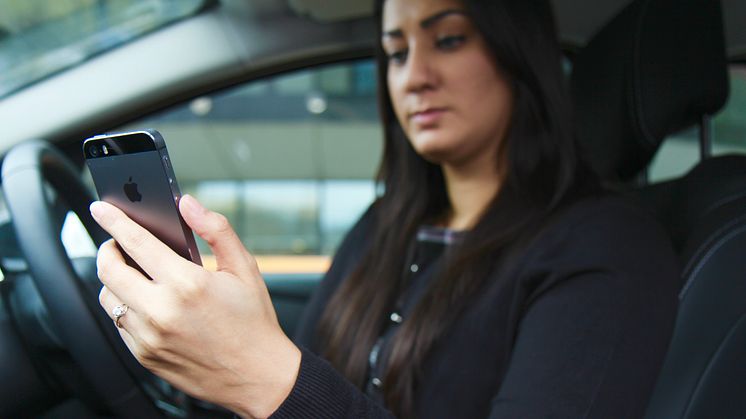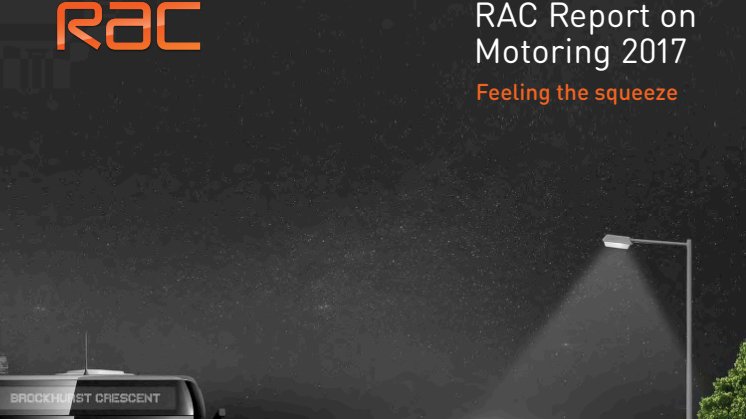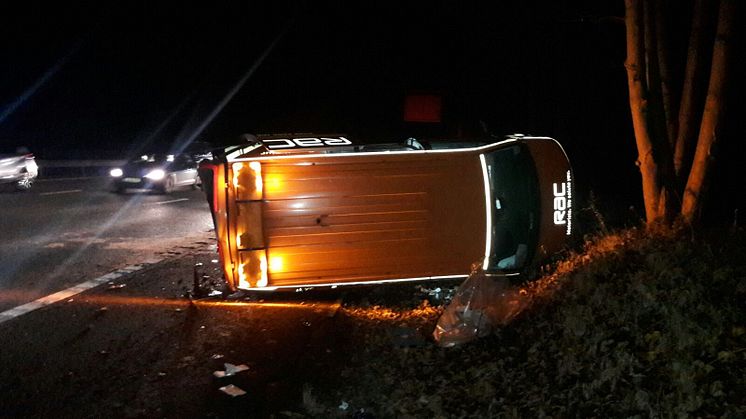
Press release -
Nine million habitual illegal handheld phone drivers refuse to quit
A hard-core of motorists still admit to flouting the law by habitually using their handheld phones while driving despite penalties for the offence being doubled on 1 March, new RAC research has found.
In September 2016 the RAC revealed that the illegal use of handheld mobile phones at the wheel to ‘snap, chat, text and tweet’ had reached epidemic proportions. Days later the Government announced the penalty for the offence would increase to six points and a £200 fine in a bid to stamp out the dangerous habit.
Twelve months on, however, research carried out with 1,727 motorists for the RAC’s Report on Motoring 2017 shows the move has not stopped a persistent 9.2m drivers breaking the law on a regular basis.
While the number of motorists who say they make or receive calls illegally at the wheel has fallen by a quarter (31% in 2016 v 23% in 2017), of those questioned about the impact of the tougher penalties 15% – or 5.3m drivers – said this had not made them stop. This is split between 8% (2.8m) who said they had not changed their habit at all and 7% (2.5m) said it had not really made a difference.
Of the 89% of drivers who said they were aware of the tougher penalties for mobile phone use, the Report identified six in 10 (58%) – or the equivalent of 20.6m drivers – who said they had never used their handheld mobile phone when driving. Sixteen per cent – or 5.7m drivers – said they had completely stopped using their handheld phone altogether when driving since the law change.
A further 11% – 3.9m drivers – said they had curbed their illegal behaviour ‘a little’ but these occasional ‘illegal handheld phone use’ drivers have not broken their habit for good. It should be pointed out that this does not include the 11% – 4.4m of all UK drivers – who stated they were not aware of the law change so the figures for illegal phone use could in fact be higher.
RAC road safety spokesman Pete Williams said: “Twelve months ago our research revealed that the illegal use of handheld mobile phones by drivers was at epidemic proportions – a year on and the situation still remains dire. Despite the law change and some high profile police enforcement campaigns we are in a situation where overall roads policing officer numbers are down on 2016 by a massive 30% since 2007*.
"It is clear we have a hard core of persistent offenders who believe they can get away with it by continuing to flout the law every day and we fear this may get worse with fewer dedicated roads policing officers.”
A stationary problem
Every figure for every form of illegal handheld phone use is worse when vehicles are stationary compared to on-the-move, indicating that many motorists think that it is safe to interact with a handheld phone when stopped in traffic.* This year four in 10 (40% or 15.9m) motorists owned up to talking on their phone when stationary in traffic compared to 48% in 2016 – a 16.6% fall – a far lesser reduction than those who admit doing it while driving (25%). The reduction for all illegal phone use while driving is down 28.7% on 2016 whereas the stationary equivalent reduced by just 20.1%.
Four in 10 (39%) – or 15.6m drivers – also say they have checked texts, emails and social media while stationary in traffic and a shocking third (29%, or 11.6m drivers), say they have written texts, emails or social posts when stationary in traffic. In addition, 16% (the equivalent of 6.4m drivers) say they have taken photos or video when stationary in traffic which is down a quarter (27.3%) on a year ago when 22% admitted to this highly irresponsible activity.
Pete Williams continued: “More has to be done to educate drivers that any use of a handheld phone at the wheel is both illegal and presents both a mental and a physical distraction that could ultimately cause a crash and the loss of life. The Government, and indeed all those who campaign on road safety, need to impress on drivers the dangers of being distracted at the wheel and the consequences of using a handheld mobile phone while driving.
“Drivers need to take more responsibility when they get behind the steering wheel and think seriously about whether choosing to pick up a handheld mobile phone is really worth the risk.”
UK’s #1 motoring concern
The illegal use of handheld phones by drivers was named as the number-one concern for motorists surveyed for this year’s RAC Report on Motoring, with 16% citing it as their top worry from a list of 23 common concerns. This was up from 13% in 2016 and from 9% in 2015.
In comparison to the 16% citing mobile phone use as their top concern 10% ranked the condition of local roads, 9% ranked the cost of fuel and 8% the cost of insuring a car as their number-one concern. Overall, 40% of drivers listed illegal handheld mobile phone use – and the distraction it inevitably causes – as one of their top four concerns, very similar to last year’s 41%.
Pete Williams said: “We had hoped concern about drivers talking or texting at the wheel on their handheld phone would decline as a result of the Government taking the decision to increase penalties with fewer drivers breaking the law but this has not been the case. What may well have happened is that awareness of the offence has risen among law-abiding drivers who have become increasingly incensed by the number of drivers they still see flouting the rules. For drivers who don’t do it there is nothing more frustrating than seeing others blatantly using a handheld phone at the wheel on a daily basis and putting other road users at serious risk of injury or even death.
“The numbers of drivers still using their handheld phones at the wheel remains at epidemic levels and is a serious problem for society. The Government, police and road safety organisations still have a huge job to do to end the handheld mobile phone menace.”
Handheld mobile phone use by age and gender
Among the hard core of drivers who are habitual handheld phone law breakers (15%) there appears to be a significant split between the ages with four in 10 (39.6%) aged 25 to 44, a third (33%) aged 45 to 64 and almost one in five (18.5%) aged 17 to 24. Men make up the larger proportion of the hard core with 57.3% compared to women with 42.7%.
One in five occasional handheld phone users (21.8%) were aged 17 to 24, six in 10 (59.7%) aged 25 to 44 and 16% aged 45 to 64. There was a more even split between men (51.7%) and women (48.8%).
Among reformed users 16.4% were aged between 17 and 24, 46.4% were aged 25 to 44 and 28.8% aged 45 to 64. Women were more inclined to quit, making up 54.4% of this percentage compared with 45.6% men.
Table showing handheld mobile phone use at the wheel, among the 89% of motorists who said they were aware of the new penalties which came into force 1 March 2017
| Total | Age 17-24 | Age 25-44 | Age 45-64 | Age 65+ | Men | Women | |
| Hard core habitual users | 15% 5.3m | 21% | 17% | 15% | 6% | 17% | 13% |
| Occasional users – trying to quit | 11% 3.9m | 20% | 20% | 5% | 1% | 12% | 11% |
| Reformed users – stopped in last 12 months | 16% 5.7m | 21% | 23% | 14% | 7% | 15% | 18% |
| Non-users – never used a handheld phone at the wheel | 58% 20.6m | 38% | 40% | 66% | 86% | 56% | 59% |
Reasons for illegal handheld phone use at the wheel
The reasons given by drivers for using a handheld phone at the wheel range from ‘It was an emergency’ cited by one in five (18%) – down from 24% in 2016, to ‘I needed information for my journey’ – 17%, down from 21% a year ago. More telling were the following reasons: ‘I’m in the habit of doing so’ (12%, up from 11% in 2016); ‘I can get away with it’ (10%, up from 7% in 2016); ‘I didn’t realise it was illegal’ (9%, up from 7% in 2016); and ‘Everyone else does it’ (5%, down from 7% in 2016).
Awareness of tougher penalties
There are signs that the Government’s tougher stance on handheld phone use has had some impact. This year’s Report found high levels of awareness about the tougher law with nine in 10 drivers (89%) aware of the new penalties which came into force on 1March this year. Just one in 10 (11%) said they didn’t know that the fine and points that you receive if caught using your handheld phone when driving had increased. However, just a quarter (27%) knew the detail that the fine has doubled to £200 and the points have gone up to six.
Similarly only one in four drivers (28%) were aware that the Government has recommended that those caught should not be offered a ‘driver offender retraining’ course but should automatically receive the full penalty.
Further fall in roads policing numbers
A factor that may be influencing persistent driving illegal behaviours is the reduction in the number of dedicated roads policing officers. In England and Wales the number has declined by 30% in 10 years from 3,766 in 2007 to just 2,643 in 2017*.
The Report has revealed that a concerning proportion of motorists do not expect to be caught if they break motoring laws – although the 24% who agree with this sentiment is a drop on the 27% recorded last year. Meanwhile a majority of drivers (62%) still feel there are not enough roads policing officers to enforce traffic laws effectively.
Be Phone Smart campaign
The RAC launched its Be Phone Smart campaign in March 2017 in an attempt to encourage drivers to kick their handheld mobile phone habit. The campaign encourages motorists to make a personal commitment not to use their handheld phone when at the wheel and has the backing of a wide range of organisations including the National Police Chiefs’ Council, the Government’s THINK! campaign, IAM RoadSmart, the Road Haulage Association, Road Safety GB and Transport Scotland.
Pete Williams said: “While we can only hope that the hard core of offenders who persist in using their handheld phones regardless of the significant risks involved will feel the full weight of the law – the reality is that this may not be the case because of the declining number of roads police. However, there is an opportunity to appeal to those motorists who have curbed their behaviour a little, but admit to occasionally slipping back into the habit, to stop using their handheld phone at the wheel once and for all.
“The Be Phone Smart campaign, including the BePhoneSmart website, encourages drivers to do exactly this by making a promise to stop using their handheld phone at the wheel and to share their pledge with friends and family via social media. It also offers advice and tips on how to break the habit and quit for good."
Table showing handheld mobile phone use by activity when driving
| Handheld phone activity at the wheel – WHEN DRIVING | 2016 | 2017 | Reduction | 2017 numbers |
| Drivers who admitted to using their handheld phone to make or receive a call | 31% | 23% | 25.8% | 9.2m |
| Drivers who admitted to checking texts, emails or social media | 26% | 18% | 30.8% | 7.2m |
| Drivers who admitted to writing texts, emails or social media posts | 19% | 13% | 31.6% | 5.2m |
| Drivers who admitted to taking photos or videos | 15% | 11% | 26.6% | 4.4m |
| Total average reduction for all handheld mobile phone use in the last 12 months when driving | 28.7% |
Table showing handheld mobile phone use by activity when stationary in traffic
| Handheld phone activity at the wheel – STATIONARY, IN TRAFFIC | 2016 | 2017 | Reduction | 2017 numbers |
| Drivers who admitted to using their handheld phone to make or receive a call | 48% | 40% | 16.6% | 16m |
| Drivers who admitted to checking texts, emails or social media | 46% | 39% | 15.2% | 15.6m |
| Drivers who admitted to writing texts, emails or social media posts | 37% | 29% | 21.6% | 11.6m |
| Drivers who admitted to taking photos or videos | 22% | 16% | 27.3% | 6.4m |
| Total average reduction for all handheld mobile phone use in the last 12 months when stationary in traffic | 20.1% |
Related links
Topics
Categories
Notes to Editors
The RAC’s 29th annual Report on Motoring is based on a large-scale online survey in which we surveyed a representative sample of 1,727 UK motorists in May 2017.
* Press Association – Freedom of Information question to UK police forces July 2017
** DVLA Driver licence data – June 2017. Total of 39.98m full driving licence holders.
About the RAC
First formed in 1897 the RAC has been looking after the needs of its members and championing the interests of motorists for 120 years.
Today it has more than eight million members and is one of the UK’s most progressive motoring organisations, providing services for both private and business motorists. Whether it's roadside assistance, insurance, buying a used car, vehicle inspections and checks, legal services or up-to-the-minute traffic and travel information – the RAC offers a solution for all motoring needs. The RAC is committed to making motoring easier, safer, more affordable and more enjoyable for drivers and road users.
The RAC is the motorist’s champion and campaigns to support the interests of its members and UK motorists at a national level. This includes voicing concerns about the increasing cost of motoring, particularly the price of fuel and the high level of tax levied on it, advancing levels of road safety, and supporting the needs of all drivers, from young to old.
The RAC’s annual Report on Motoring – first published in 1989 – provides a clear insight into the concerns and issues facing today’s motorists.
For the very latest news on UK fuel prices, check RAC Fuel Watch or follow #racfuelwatch on Twitter. RAC Fuel Watch is a comprehensive guide to the latest UK unleaded petrol and diesel prices – both at the wholesale level and at the pump. RAC Fuel Watch analyses how prices changed through the previous month and compares the most recent prices with those from three, six and 12 months before.
Key facts:
- RAC patrols fix four out of five vehicles at the roadside and on average within 30 minutes
- RAC vans carry more than 500 parts and tools to get members’ vehicles going again
- 92% of members would recommend RAC Rescue to their friends and family



